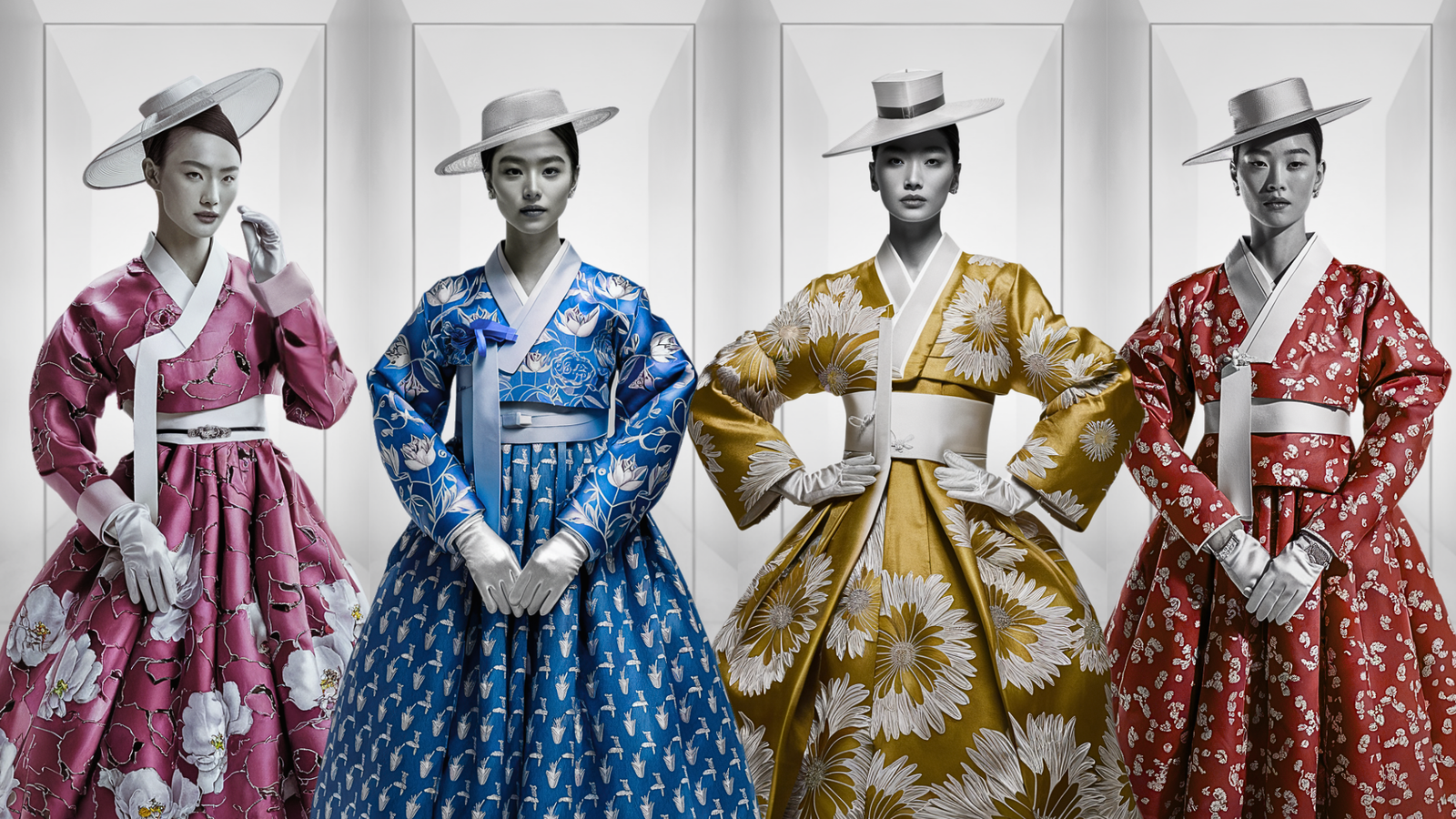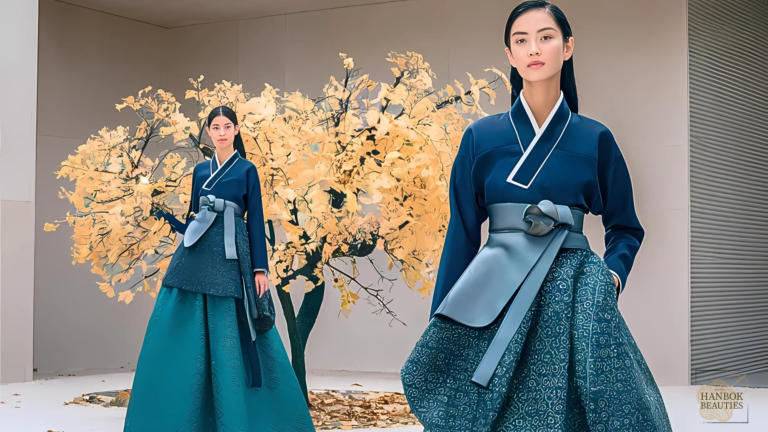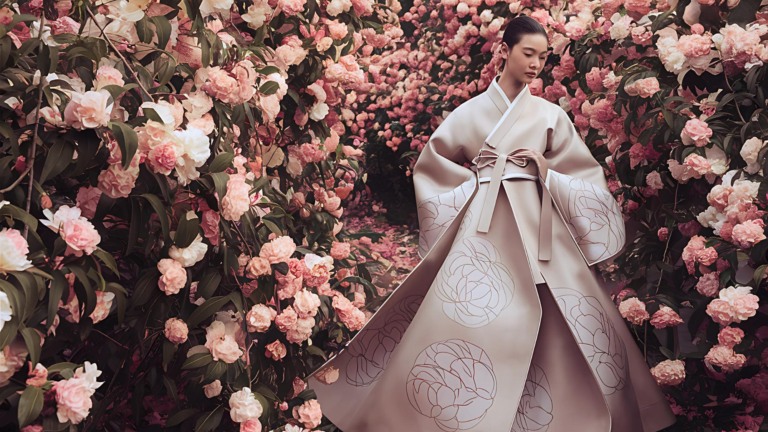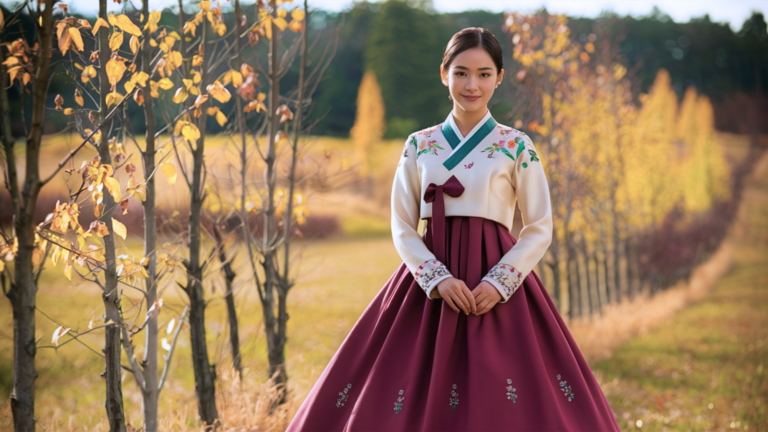Sacred Blooms: A Guide to Floral Designs in Women’s Hanbok
For over two thousand years, floral motifs have reigned supreme in Korean textile arts. From spring’s delicate plum blossoms to royal peonies, each floral hanbok design reveals a legacy of deep cultural meaning. Perfected through centuries of innovation, these treasured patterns continue to inspire modern women’s hanbok while preserving traditional Korean artistry. These patterns form the cornerstone of women’s hanbok aesthetics across all seasons and occasions.
Understanding Korean Floral Symbolism in Hanbok
Floral patterns in women’s hanbok trace their origins to the Three Kingdoms period (57 BCE-935 CE). Simple geometric blooms evolved into sophisticated designs during early Joseon (1392-1700). By late Joseon (1700-1910), master artisans elevated these patterns through increasingly elaborate embroidery techniques, incorporating precious materials like gold thread in women’s formal hanbok. The evolution of women’s hanbok patterns reflects changing social roles while maintaining cultural significance.
This rich heritage lives on through five traditional pattern placements that reflect Korean cultural values. These designs in women’s hanbok weren’t just decorative – they expressed collective aspirations and cultural ideals. When lotus patterns grace a hanbok’s hem, they represent the wearer’s appreciation for purity as a virtue, not a personal claim to it. Similarly, peonies near the shoulders don’t declare prosperity but rather celebrate it as a blessing. This subtle expression of shared values through floral symbolism remains central to women’s hanbok design today.
Understanding the language of symbols is essential for appreciating women’s hanbok design. Each flower’s placement conveys specific virtues: peonies near the shoulders represent prosperity, lotus at the hem symbolizes purity, while the Four Gracious Plants express scholarly ideals. These time-honored principles transform modern hanbok into visual poetry. Discover more about hanbok’s cultural heritage in Hanbok: The Living Canvas of Korean Culture.
Categories of Traditional Floral Design
The evolution of women’s hanbok design reflects three distinct traditions of floral artistry. Each tradition originated from specific segments of Korean society – scholarly, royal, and everyday life. As hanbok designs evolved over centuries, these traditions adapted to create the patterns we see in modern women’s hanbok today.
| Pattern Categories | Scholar’s Patterns | Royal Court Patterns | Seasonal Patterns | Original Use | Men’s Formal | Royal Ceremony | Daily Wear | Modern Application | Women’s Formal Hanbok | Modern Ceremonial Hanbok | Contemporary Women’s Hanbok | Seasons | Year-round | Special Events | Season-specific | Key Flowers | Four Gracious Plants | Peonies, Lotus | Varies by season |
|---|
Among these three traditions, the Scholar’s patterns hold particular significance for their profound influence on Korean textile arts. Their systematic approach to design and symbolism laid the groundwork for many floral patterns still used in women’s hanbok. The historical painting below captures Korean scholars in their traditional setting, where these influential patterns first emerged and developed their deeper meanings.

I. Scholar’s Patterns
The Scholar’s tradition established the foundational principles for women’s hanbok patterns through its systematic approach to floral symbolism. Unlike court patterns that emphasized status or seasonal motifs that celebrated nature, Scholar’s patterns developed a comprehensive design language that influenced all aspects of hanbok decoration. These patterns transformed simple floral motifs into meaningful symbols that continue to resonate in modern Korean dress.
The Four Gracious Plants (사군자) stand at the center of this design tradition. Originally featured on scholars’ formal attire, these four plants – plum blossoms, orchids, chrysanthemums, and bamboo – expressed core Confucian values through natural forms. When incorporated into women’s hanbok, these motifs maintained their traditional meanings while adapting to feminine aesthetics. Each plant represents a specific season and virtue, forming a design system that modern hanbok makers still reference today.

Winter/Early Spring: Plum Blossoms
First to bloom in harsh winter, plum blossoms represent scholarly resilience. These patterns show delicate five-petaled blooms on dark branches, expressing integrity in adversity. Explore the rich tradition of winter blooms in our article How Winter Flowers Elevated Women’s Hanbok Design.
Modern women’s hanbok features plum blossom designs in various forms. Abstract prints appear on casual wear, while formal winter attire showcases traditional embroidered patterns. Digital printing allows for delicate gradient effects across entire garments.
Spring: Orchids
Growing quietly in mountain forests, orchids symbolize refined nobility. These elegant patterns showcase long, graceful leaves and subtle blooms, representing cultured dignity.
Today’s hanbok incorporates orchid motifs through both traditional and contemporary methods. Subtle watercolor-style prints grace everyday pieces, while formal wear maintains hand-embroidered details. Modern designers also feature minimalist interpretations in tone-on-tone patterns.
Summer: Bamboo
Standing tall through all seasons, bamboo embodies unwavering principles. The pattern features precise, sectioned stalks and detailed leaves, showing strength with flexibility.
Contemporary women’s hanbok presents bamboo patterns in innovative ways. Screen printing creates bold geometric interpretations, while subtle jacquard weaving offers elegant texture. Casual summer pieces often feature simplified bamboo motifs in repeating patterns.
Autumn: Chrysanthemums
Blooming last as frost approaches, chrysanthemums represent scholarly perseverance. These complex patterns require intricate layering to capture the flower’s fullness.
Modern floral hanbok reimagines chrysanthemum designs through multiple techniques. Digital printing captures complex color gradations, while laser-cut appliqués add dimensional elements. Casual autumn pieces feature abstract chrysanthemum patterns in contemporary color combinations.
II. Ceremonial and Court Patterns
Women’s ceremonial hanbok represents the pinnacle of floral pattern artistry, especially in wedding designs. Royal court traditions established strict rules for pattern placement and combinations. These guidelines continue to influence modern hanbok while preserving traditional design principles. These ceremonial women’s hanbok patterns continue to influence contemporary formal wear.

Wedding and Celebration Designs
The bride’s hanbok features the most elaborate floral patterns in Korean dress tradition. Peony and lotus motifs dominate wedding designs, symbolizing prosperity and purity. Master artisans combine these patterns with phoenixes and other auspicious symbols for marital harmony. Modern wedding hanbok preserves these traditional motifs while incorporating contemporary embroidery techniques.
Royal Court Traditions
Court hanbok from the Joseon Dynasty showcases the most sophisticated floral pattern combinations. Artisans used gold-thread embroidery to create peony patterns near the shoulders of women’s ceremonial robes. The placement and size of each motif followed strict hierarchical rules based on the wearer’s status.
Auspicious Combinations
Traditional pattern combinations carry specific meanings in women’s hanbok design. Peonies paired with butterflies represent joy and wealth, while pomegranate blossoms
symbolize fertility. Pine and plum blossom combinations express longevity. Modern designers respectfully adapt these meaningful patterns for contemporary ceremonial wear.
III: Seasonal Patterns
Women’s hanbok designs change with Korea’s distinct seasons, each bringing its own floral vocabulary. Seasonal patterns reflect nature’s cycles through carefully chosen motifs and color combinations. These designs allow women to harmonize their dress with the natural world.
Women’s hanbok designs change with Korea’s distinct seasons, each bringing its own floral vocabulary. Seasonal patterns reflect nature’s cycles through carefully chosen motifs and color combinations. These designs allow women to harmonize their dress with the natural world. Learn more about seasonal transitions in hanbok in our guide on The Art of Seasonal Hanbok: Transitioning from Summer to Autumn.
Spring and Summer Designs

Spring hanbok celebrates the awakening of nature through delicate peach blossom and peony patterns in traditional floral designs. For more insights on seasonal transitions, explore our guide on The Art of Seasonal Hanbok: Transitioning from Summer to Autumn. Modern hanbok interpretations include watercolor-style prints and subtle tone-on-tone patterns, maintaining the elegance of traditional motifs while appealing to contemporary tastes.
Summer traditional hanbok showcases a rich variety of floral patterns. Lotus designs symbolize purity amid summer’s heat, while pomegranate blossoms represent abundance and fertility. Crape myrtle adds delicate beauty to these classic hanbok designs. Traditional techniques layer threads to show each flower’s unique characteristics – from lotus buds unfurling to full blooms, pomegranate’s distinctive shape, and crape myrtle’s clustered petals. Contemporary hanbok designers offer fresh approaches through digital printing and abstract interpretations.
Autumn and Winter Motifs

Autumn patterns in women’s hanbok showcase chrysanthemums, begonias, and maple leaves in rich seasonal colors. Artisans layer threads to capture begonia’s distinctive petal structure alongside dimensional chrysanthemum embroidery. Modern designs incorporate these autumn motifs through digital printing, metallic accents, and fabric textures. Discover more autumn-inspired patterns in our articles 6 Iconic Motifs in Fall Seasonal Hanbok: A Visual Journey and 5 Lesser-Known Motifs in Fall Seasonal Hanbok: Hidden Gems of Korean Tradition.
Winter hanbok showcases resilient motifs – camellia, winter plum, and evergreen bamboo. Traditional patterns emphasize stark beauty through precise threadwork on darker fabrics, often pairing bamboo’s straight lines with plum’s delicate blooms. Contemporary winter designs might feature simplified motifs in metallic threads or tonal patterns.
Choosing Your Floral Hanbok Design
When choosing your floral hanbok design, consider how occasion and season work together to create perfect color harmony. Special events like weddings call for auspicious patterns in traditional color combinations, while seasonal choices naturally guide your selection of both flowers and colors. For guidance on seasonal color selection, explore our guides on Autumn’s Palette: 5 Timeless Warm Tones and Cool Hues: 5 Essential Autumnal Colors for Fall Seasonal Hanbok. Whether for formal occasions or seasonal celebrations, achieving the right balance of pattern and color will ensure your hanbok honors traditional aesthetics while reflecting personal style.
| HANBOK GUIDE | TRADITIONAL PATTERNS | MODERN DAILY WEAR | DESIGNS FOR SPECIAL OCCASIONS | SPRING | • Cherry and peach blossoms<br> • Peonies<br> • Young bamboo shoots<br> • Plum blossoms<br> • Fresh spring herbs | • Colors: Soft pink, mint green, pale yellow<br>• Motifs: Simplified flower prints<br>• Abstract peony patterns<br>• Minimalist blossom designs | • Color scheme: Pastel pinks with white and pale green accents<br>• Special floral motifs: Detailed peony embroidery, layered cherry blossom clusters<br>• Perfect for outdoor weddings and spring festivals | SUMMER | • Lotus flowers<br>• Pomegranates<br>• Morning glories<br>• Hydrangeas<br>• Summer roses | • Colors: Cool blues, crisp whites, light purples<br>• Motifs: Minimalist lotus designs<br>• Stylized hydrangea patterns<br>• Abstract floral elements | • Color scheme: Pure white with blue accents, light jade green<br>• Special floral motifs: Elaborate lotus flowers, cascading wisteria<br>• Ideal for summer ceremonies and outdoor events | AUTUMN | • Chrysanthemums<br>• Maple leaves<br>• Wild grasses<br>• Pine needles<br>• Ginkgo leaves | • Colors: Burgundy, rust orange, deep gold<br>• Motifs: Modern maple leaf designs<br>• Geometric autumn foliage<br>• Simplified chrysanthemum prints | • Color scheme: Deep red with gold accents, rich brown tones<br>• Special floral motifs: Detailed chrysanthemum embroidery, intertwined maple and ginkgo leaves<br>• Perfect for harvest festivals and formal autumn events | WINTER | • Plum blossoms<br>• Pine branches<br>• Winter bamboo<br>• Snow flowers<br>• Winter berries | • Colors: Deep blue, winter white, charcoal grey<br>• Motifs: Minimal pine needle designs<br>• Stylized plum blossom patterns<br>• Modern winter botanical prints | • Color scheme: Deep navy with silver accents, pure white<br>• Special floral motifs: Embroidered plum blossoms, eternal pine patterns<br>• Suitable for winter ceremonies and new year celebrations |
|---|
Celebrating Korea’s Floral Legacy
Each floral design in women’s hanbok tells a unique story. While peonies wish prosperity for brides and lotus patterns grace formal occasions, seasonal blooms mark nature’s changing rhythms. These thoughtfully chosen flowers, passed down through generations of artisans, continue inspiring new interpretations while preserving their deep cultural meaning. To explore regional variations of these traditions, read our articles on 6 Enchanting Secrets of Jeju’s Fall Seasonal Hanbok and Jeolla’s Fall Seasonal Hanbok: Southwestern Korea’s Unique Harvest Styles.
Whether selecting traditional hanbok for women’s hanbok or seasonal motifs for everyday wear, your hanbok becomes part of this enduring artistic tradition. The beauty of these designs lies not just in their visual appeal, but in their power to connect us to Korea’s rich cultural heritage.





